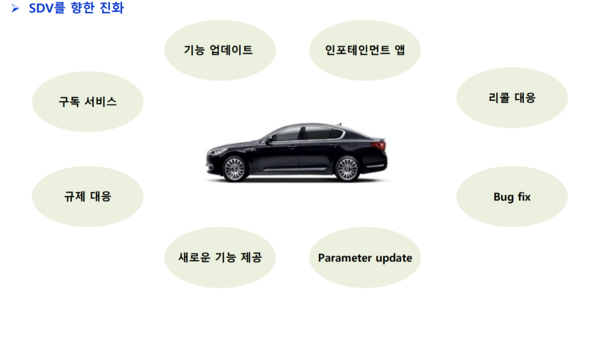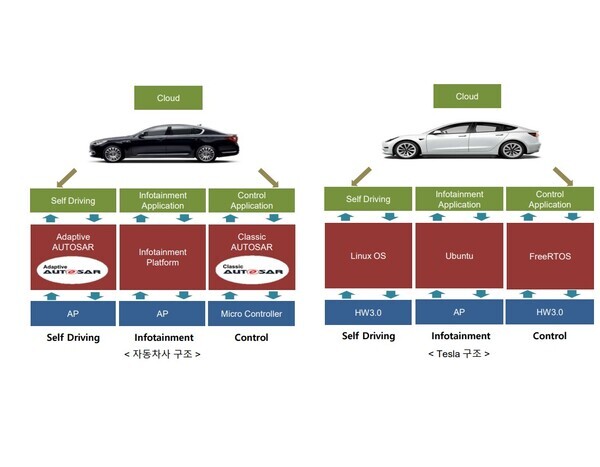Changes in industrial ecology and future assignments due to SDV expansion.

[Consumerwide - HueSoung Jun Reporter / Yohan Bok Reporter] The paradigm shift in the vehicle industry, which involves environmental and technological change, has resulted in the growth of Chinese manufacturers centred around Tesla and BYD, along with the expansion of the Chinese market globally based on their battery, AI, and S/W technologies. Meanwhile, major countries, such as the US, are focusing on protectionist policies to secure future industries in the global and national markets. Having all this background, it's been more emphasised the importance of coordinated work between government, academia, and the private sector. I had the opportunity to hear about the opinions of experts in public and private partnerships regarding the method to strengthen future competitiveness in the vehicle industry during a conference held to celebrate 21st Automobile Day on May 9 at 9:30 a.m. at the JW Marriott Hotel Gangnam Grand Ballroom.
The third story is about a change in industrial ecology due to SDV expansion and future assignments by Jeong Gumin, the professor at Kukmin University.

The prospective and application of SDV (Software Defined Vehicle) differ according to the industries. Referring to the OS development report, which is a basement of SDV development, published by the Hyundai Motor blog, software defines the vehicle's driving capacity, convenience and safety functions, emotional quality, and brand identity. In particular, the vehicles can perform new functions, such as software and firmware update functions based on wireless communication (OTA), and offer E/E architecture, which connects in-vehicle ECUs and sensors and provides convenience, driving, infortainment, ADAS functions, and a service platform (OEM, third parties handle those services.). SDV can support convenience aspects, such as the infortainment app, subscription service, and function update, and management expenses and governance aspects, such as responding to recalls and regulations. In line with the change in software platform, the E/E architecture is changing accordingly.


Currently, vehicle companies are facilitating the Classic AUTOSAR, a standard software platform, and it is recently evolving to the Adaptive AUTOSAR according to the self-driving trend. The infortainment, which used to take the platform invented by each company while competing with the Android platforms, is now accepting Android Automotive, which is a variation of Google's Android operating system, customised to vehicle dashboards, including Tesla, in order to survive.
Many estimate that the SDV platform will be stabilised by 2030 at maximum, and they foresee that this will be the time when self-driving vehicles will develop on a full scale.
Referring to the "Where Will Software Drive the Auto Industry Next?/2023.10,BCG" report, 1.2 trillion dollars of profit, which is a 12% increase annually, is estimated in the software and electronic sectors of the vehicle market due to SDV transformation between 2023 and 2035. This might take approximately 15 to 20% of the overall profit from a vehicle sale. Besides, the SDV market will grow to 0.411 trillion dollars in 2030 from 0.236 trillion dollars in 2023, and particularly, the vehicle application sector will grow to 0.209 trillion dollars.

Then, what would be the industrial ecology caused by SDV? Jeong Gumin, the professor of Kukmin University, said, "SDV can maintain the value of used vehicles through a constant software update (OTA), which might secure price competitiveness. It is capable of responding to software adjustments and recalls, which will save management expenses, and it will create a new sector of business based on subscription services. Besides, the vehicle companies will change their future business direction from individual model platform development to an in-house software platform, and failures to adopt the in-house ecology, which is based on convegence, might constantly face challenges."

The professor, Jeong, sees that the expansion of the SDV trend will also have an influence on the hardware market, and the connected car market will take the majority in the future. "It is possible that the SDV platform, which is based on a top-down software design system, influences the hardware and part markets. The vehicle manufacturer might influence the market hugely in the entire vehicle market. The market is paying attention to what sector of the infortainment (connected car) market will take centre stage in SDV. However, cooperative work between ICT and vehicle sectors is essential, as a stable SDV platform will bring large growth to the self-driving vehicle market."

The professor, Jeong, said, "The development of the SDV platform might result in an exclusive ecology. The vehicle parts and hardware market might change accordingly. The infortainment sector of the market, including the self-driving market and subscription services, will grow in the connected car market, and we've got to get ready for it. Making a corporative system between the software, hardware, vehicle manufacturers, and ICT industries is fundamental to adopting the SDV market."
- [Consumption value-10th anniversary/In-Depth Report] 3 experts in public and private partnerships explore strategies to improve the vehicle sector's competitiveness. ②
- [Consumption value-10th anniversary/In-Depth Report] 3 experts in public and private partnerships explore strategies to improve the vehicle sector's competitiveness ①

